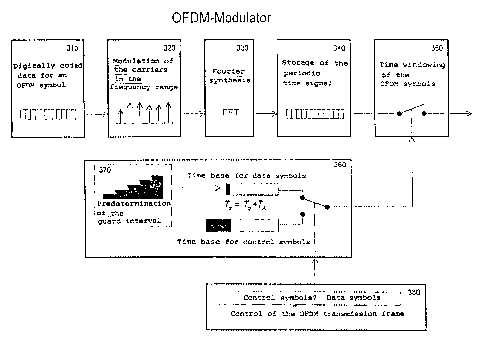Some of the information on this Web page has been provided by external sources. The Government of Canada is not responsible for the accuracy, reliability or currency of the information supplied by external sources. Users wishing to rely upon this information should consult directly with the source of the information. Content provided by external sources is not subject to official languages, privacy and accessibility requirements.
Any discrepancies in the text and image of the Claims and Abstract are due to differing posting times. Text of the Claims and Abstract are posted:
| (12) Patent: | (11) CA 2194394 |
|---|---|
| (54) English Title: | CONTROL SYMBOL AND DATA SYMBOL GUARD INTERVALS WITH DIFFERENT TIME LENGTHS IN COFDM TRANSMISSION FRAMES |
| (54) French Title: | TRANSMISSION PAR PORTEUSES MULTIPLES DANS DES RESEAUX DE TRANSMISSION SUR ONDE COMMUNE |
| Status: | Term Expired - Post Grant Beyond Limit |
| (51) International Patent Classification (IPC): |
|
|---|---|
| (72) Inventors : |
|
| (73) Owners : |
|
| (71) Applicants : |
|
| (74) Agent: | JOHN K. CARTONCARTON, JOHN K. |
| (74) Associate agent: | |
| (45) Issued: | 2001-12-25 |
| (86) PCT Filing Date: | 1995-07-20 |
| (87) Open to Public Inspection: | 1996-02-01 |
| Examination requested: | 1997-01-03 |
| Availability of licence: | N/A |
| Dedicated to the Public: | N/A |
| (25) Language of filing: | English |
| Patent Cooperation Treaty (PCT): | Yes |
|---|---|
| (86) PCT Filing Number: | PCT/EP1995/002868 |
| (87) International Publication Number: | WO 1996002989 |
| (85) National Entry: | 1997-01-03 |
| (30) Application Priority Data: | ||||||
|---|---|---|---|---|---|---|
|
In order to prevent wanted signal capacity from being reduced during OFDM
modulation of digital coded data, control symbol protecting intervals in the
frame head of each OFDM transmission frame are larger than data symbol
protecting intervals in wanted data areas of each OFDM transmission frame. The
length of data symbol protecting intervals is determined during demodulation
and data symbol scanning times are then determined depending on the thus
determined length of the protecting intervals.
Afin d'éviter que la capacité de transmission de signaux utiles ne soit réduite lors de la modulation par multiplexage par répartition orthogonale de la fréquence de données codées numérisées, les intervalles de protection des symboles de commande dans la tête de chaque trame de transmission de multiplexage par répartition orthogonale de la fréquence sont plus grands que les intervalles de protection des symboles de données dans la zone des données utiles de chaque trame de transmission de multiplexage par répartition orthogonale de la fréquence. La longueur des intervalles de protection des symboles de données est déterminée pendant la démodulation et les moments d'analyse des symboles de données sont ensuite déterminés en fonction de la longueur ainsi déterminée des intervalles de protection.
Note: Claims are shown in the official language in which they were submitted.
Note: Descriptions are shown in the official language in which they were submitted.

2024-08-01:As part of the Next Generation Patents (NGP) transition, the Canadian Patents Database (CPD) now contains a more detailed Event History, which replicates the Event Log of our new back-office solution.
Please note that "Inactive:" events refers to events no longer in use in our new back-office solution.
For a clearer understanding of the status of the application/patent presented on this page, the site Disclaimer , as well as the definitions for Patent , Event History , Maintenance Fee and Payment History should be consulted.
| Description | Date |
|---|---|
| Inactive: Expired (new Act pat) | 2015-07-20 |
| Inactive: IPC deactivated | 2011-07-29 |
| Inactive: Late MF processed | 2010-10-08 |
| Letter Sent | 2010-07-20 |
| Inactive: IPC from MCD | 2010-02-01 |
| Inactive: IPC expired | 2008-01-01 |
| Inactive: IPC from MCD | 2006-03-12 |
| Inactive: Entity size changed | 2002-07-12 |
| Grant by Issuance | 2001-12-25 |
| Inactive: Cover page published | 2001-12-24 |
| Inactive: Final fee received | 2001-08-28 |
| Pre-grant | 2001-08-28 |
| Letter Sent | 2001-03-09 |
| Notice of Allowance is Issued | 2001-03-09 |
| Notice of Allowance is Issued | 2001-03-09 |
| Inactive: Approved for allowance (AFA) | 2001-02-26 |
| Amendment Received - Voluntary Amendment | 2000-07-14 |
| Inactive: S.30(2) Rules - Examiner requisition | 2000-02-01 |
| Inactive: Status info is complete as of Log entry date | 1998-08-12 |
| Inactive: Application prosecuted on TS as of Log entry date | 1998-08-12 |
| All Requirements for Examination Determined Compliant | 1997-01-03 |
| Request for Examination Requirements Determined Compliant | 1997-01-03 |
| Application Published (Open to Public Inspection) | 1996-02-01 |
There is no abandonment history.
The last payment was received on 2001-06-22
Note : If the full payment has not been received on or before the date indicated, a further fee may be required which may be one of the following
Please refer to the CIPO Patent Fees web page to see all current fee amounts.
Note: Records showing the ownership history in alphabetical order.
| Current Owners on Record |
|---|
| TILMAR KONLE |
| Past Owners on Record |
|---|
| CHRISTFRIED WECK |